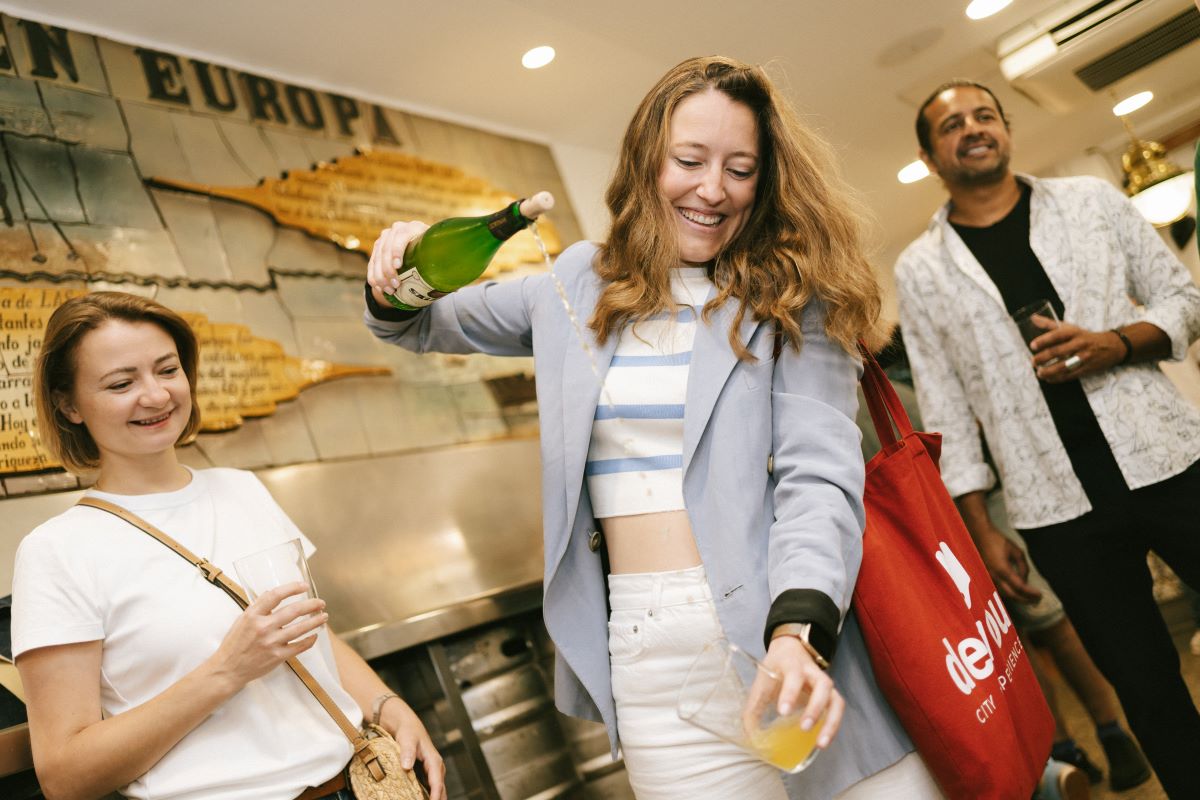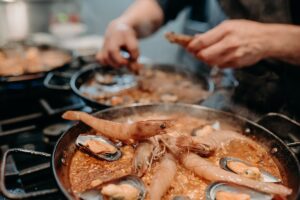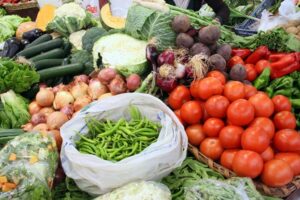Last Updated on November 21, 2025 by Cassandra Gambill | Published: April 10, 2019
In the midst of the animated chatter that fills any Basque cider house during the high season, only one word truly matters: “¡Txotx!”
That lone syllable—pronounced “choch”—is enough to empty every seat in the room as diners make their way to the massive barrels that hold the Basque Country’s single greatest alcoholic treasure. The interjection essentially means that a new barrel is about to be opened, unleashing another round of cider to the cheerful masses.
While it might seem impossible that a single five-letter exclamation can have so much influence, that’s exactly what txotx has achieved. This one word has transformed Basque cider from a drink into a social ritual enjoyed by everyone from lifelong Basque Country natives to first-time visitors to the region.

What is Basque cider?
Before you grab your glass and start running towards the nearest barrel at the first call of txotx, you should probably know what it is you’re drinking. Basque cider (called sidra in Spanish or sagardo in Basque), after all, is one of the most popular drinks in San Sebastian, but it’s a bit different from other hard ciders you may be familiar with.
The base ingredient, of course, is apples. But in order to get that prestigious D.O. Euskal Sagardoa label, only Basque apples may be used. Each bottle of cider contains around one kilo (2.2 pounds) of apples. The fruit is harvested in October; washed, chopped, and pressed; and finally left to ferment naturally in barrels without the addition of any sugars or other substances.
The final product is a dry, unfiltered, flat beverage containing about 6 percent ABV. Due to its only ingredient being apples, Basque cider is high in vitamin C, and its crisp, refreshing taste makes it easy to drink.
Cider aged in barrels.
Cider’s delicious history
Cider production in the Basque Country boasts a long and storied tradition, with the first known reference to the drink dating back to the 11th century. Within the next 100 years, cider became even more popular in Europe than wine. The Basque Country, at that time home to a flourishing population of apple orchards, was the prime source of this delicious natural nectar.
Basque cider enjoyed continued popularity throughout the medieval and Renaissance periods. There’s even proof that in the 15th and 16th centuries, Basque whaling and codfish vessels that sailed to Greenland and Newfoundland brought plenty of cider along with them on board. The drink’s alcohol content meant that it kept well without spoiling during the long voyages, and its high amount of vitamin C helped the sailors avoid the dreaded scurvy.
Cider houses and the origins of “txotx”
Basques have been enjoying cider in sagardotegi, or cider houses, for hundreds of years. Often housed in rustic, traditional farmhouses, they originally were simply the places where locals would go to buy cider, often bringing a meal along with them to avoid drinking on an empty stomach. The savvy owners of these establishments soon realized that serving food would help improve business even more, and the sagardotegi began to take on even greater importance as social spaces where friends and family would gather to share a meal and good conversation along with their cider.
Today, it’s impossible to spend any amount of time inside a Basque cider house without hearing that rallying cry of “¡Txotx!” But compared to the long and storied history of the drink itself, txotx is a newer phenomenon in comparison.
A little more than a century ago, cider producers needed to facilitate a way for potential buyers to try small amounts of their various ciders before deciding which varieties they wanted to purchase by the bottle. The solution: making a small hole in the barrel so that the cider could squirt out directly into the glass. The hole was originally covered back up with rendered animal fat, but over the years, a small wooden pick (called a txotx in Basque) was used instead. That’s right—that famous cry that gets everyone out of their seats to line up for cider essentially means “toothpick.”
“Txotx” is the cheer locals say when the plug is removed from the cider barrel. Make sure your glass is ready!
Enjoying Basque cider today
After the apples are harvested in October and the drink ferments for several months, cider season officially kicks off in the Basque Country around January 15. Before that, though, local Whatsapp groups are aflutter with conversations centered around the big moment itself, as friends plan their cider house experiences weeks in advance. After all, Spanish and Basque cultures are famously social, and nobody wants to go to the cider house without their cuadrilla (a distinctly Basque term for a group of friends).
“The excitement starts even before the 15th, when you try and set up a cider house date with your cuadrilla,” says Maialen Franco, a born-and-bred San Sebastian native. “The best thing about txotx season is that it gives you an excuse every year to get together with your friends and have an unforgettable time.”
“I’ll never forget the first time a friend took me to a cider house in the sleepy village of Astigarraga,” says San Sebastian resident Ania Wielechowska. “Everything was attractive there, from the trip to the farmhouse, to the food, to the cider pouring, to the bustling and cheerful atmosphere.”
When you step into the sagardotegi, you’ll be handed a glass. Take it, head into the rustic dining room, and find a table (keep in mind that more traditional establishments have high tables and no chairs, so you’ll eat standing). From there, it’s time to dig into the traditional multi-course cider house meal. The menu typically includes:
- Chorizo or txistorra sausage
- Tortilla de bacalao (salt cod omelet)
- Pan-fried cod with peppers and fried onions
- Basque txuleta steak, typically served medium rare
- Basque cheese (usually Idiazabal) with walnuts and quince jelly for dessert
As you can probably tell, local ingredients are king here in the Basque Country—it doesn’t just stop with the cider itself.
Our personal favorite course: txuleta, or glorious Basque steak. It’s always served medium-rare with nothing more than a simple sprinkling of sea salt.
The cider houses themselves are loud, bustling places full of activity, music, and laughter. Even kids are welcome to join in on the fun (although they’re served pressed apple juice rather than cider), and it’s not uncommon to see entire extended families enjoying a group lunch or dinner.
As you eat, keep your ears open for the all-important cry of “¡Txotx!” meaning that a new barrel of cider has just been cracked open. Pick up your glass, head to the cellar (just follow the crowd), and get in line at the newly opened barrel, or kupela. When holding your glass out to catch the cider, remember that you don’t need a lot (the amount of liquid in your glass should only be about three fingers high). Basque cider is meant to be enjoyed just a little bit at a time, and if you’re craving more, the next txotx will be called before you know it.
And if you’re still not convinced as to how this ritual of eat-txotx-drink-repeat can bring people together in seemingly magical ways, take a local’s word for it.
“Everyone enjoys txotx. It makes complete strangers become friends, and by the time dessert rolls around, you’ll have heard the powerful voices of men singing traditional local songs together,” says Abraham Carballo, who hails from Hernani, one of the Basque Country’s most idyllic typical cider villages.
Basque cider in the off-season
Cider season generally takes place from January through April, but if you’ll be visiting during the latter two-thirds of the year, you can still try this tasty drink. While many cider houses close up shop during the off season, there are a handful that stay open year round. If you can’t find one, plenty of bars also serve cider—one of our favorites is La Mejillonera, a favorite stop on our Ultimate Pintxos & Wine Tour where you’ll get a crash course in pouring it the traditional way (hint: the higher, the better!).
Tiger mussels and cider at La Mejillonera.
Cider plays an important role in Basque festivals throughout the year, particularly during Euskal Jaiak in September, when San Sebastian’s Cider Day takes place. This is Basque cider’s time to shine during the off season, and consists of hundreds of locals gathering in Plaza de la Constitución to enjoy the drink al fresco.
Update notice: This post was updated on August 10, 2023.
Want to try your hand at cooking local dishes? Join our Authentic Basque Cooking Class in San Sebastian! You’ll step into a restaurant kitchen and get hands-on with the Basque Country’s iconic cuisine in a small-group cooking experience.








